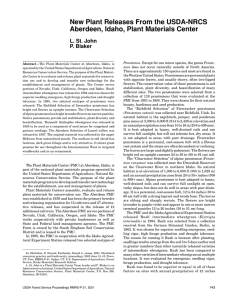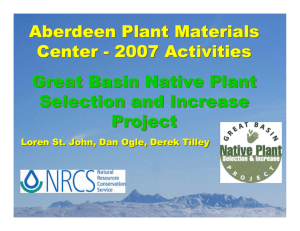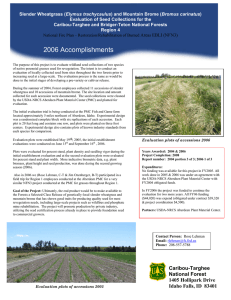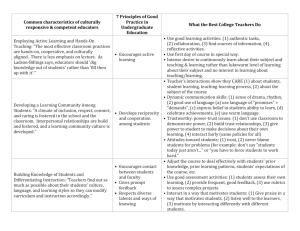New Native Plant Releases From the USDA-NRCS, Aberdeen, ID, Plant Materials Center
advertisement
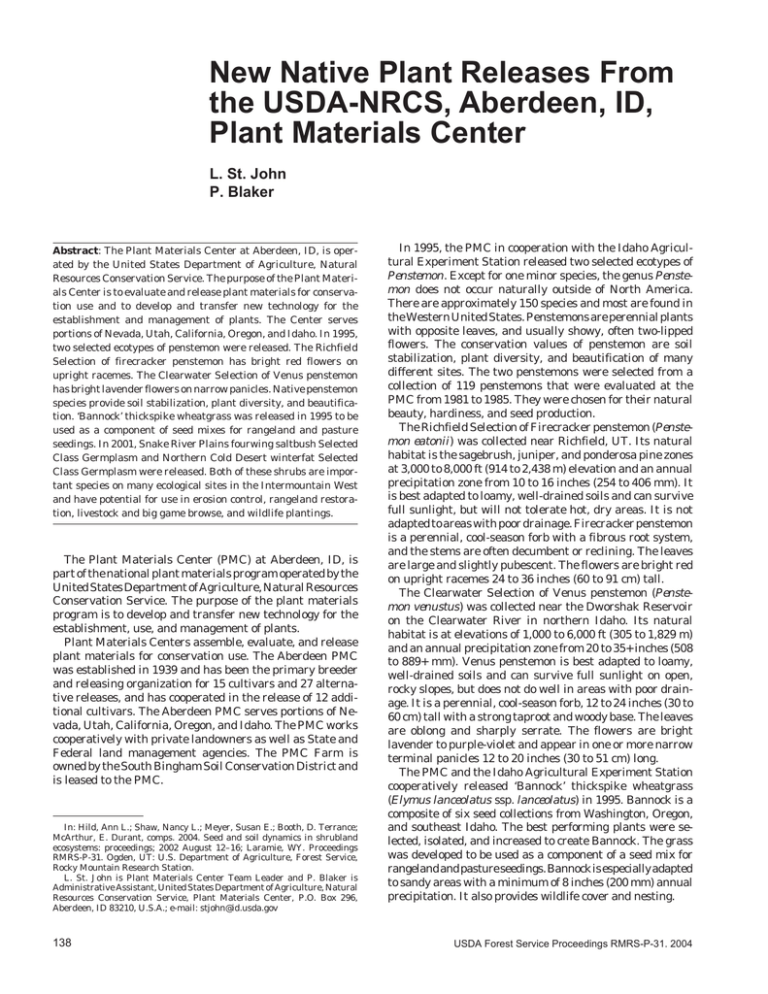
New Native Plant Releases From the USDA-NRCS, Aberdeen, ID, Plant Materials Center L. St. John P. Blaker Abstract: The Plant Materials Center at Aberdeen, ID, is operated by the United States Department of Agriculture, Natural Resources Conservation Service. The purpose of the Plant Materials Center is to evaluate and release plant materials for conservation use and to develop and transfer new technology for the establishment and management of plants. The Center serves portions of Nevada, Utah, California, Oregon, and Idaho. In 1995, two selected ecotypes of penstemon were released. The Richfield Selection of firecracker penstemon has bright red flowers on upright racemes. The Clearwater Selection of Venus penstemon has bright lavender flowers on narrow panicles. Native penstemon species provide soil stabilization, plant diversity, and beautification. ‘Bannock’ thickspike wheatgrass was released in 1995 to be used as a component of seed mixes for rangeland and pasture seedings. In 2001, Snake River Plains fourwing saltbush Selected Class Germplasm and Northern Cold Desert winterfat Selected Class Germplasm were released. Both of these shrubs are important species on many ecological sites in the Intermountain West and have potential for use in erosion control, rangeland restoration, livestock and big game browse, and wildlife plantings. The Plant Materials Center (PMC) at Aberdeen, ID, is part of the national plant materials program operated by the United States Department of Agriculture, Natural Resources Conservation Service. The purpose of the plant materials program is to develop and transfer new technology for the establishment, use, and management of plants. Plant Materials Centers assemble, evaluate, and release plant materials for conservation use. The Aberdeen PMC was established in 1939 and has been the primary breeder and releasing organization for 15 cultivars and 27 alternative releases, and has cooperated in the release of 12 additional cultivars. The Aberdeen PMC serves portions of Nevada, Utah, California, Oregon, and Idaho. The PMC works cooperatively with private landowners as well as State and Federal land management agencies. The PMC Farm is owned by the South Bingham Soil Conservation District and is leased to the PMC. In: Hild, Ann L.; Shaw, Nancy L.; Meyer, Susan E.; Booth, D. Terrance; McArthur, E. Durant, comps. 2004. Seed and soil dynamics in shrubland ecosystems: proceedings; 2002 August 12–16; Laramie, WY. Proceedings RMRS-P-31. Ogden, UT: U.S. Department of Agriculture, Forest Service, Rocky Mountain Research Station. L. St. John is Plant Materials Center Team Leader and P. Blaker is Administrative Assistant, United States Department of Agriculture, Natural Resources Conservation Service, Plant Materials Center, P.O. Box 296, Aberdeen, ID 83210, U.S.A.; e-mail: stjohn@id.usda.gov 138 In 1995, the PMC in cooperation with the Idaho Agricultural Experiment Station released two selected ecotypes of Penstemon. Except for one minor species, the genus Penstemon does not occur naturally outside of North America. There are approximately 150 species and most are found in the Western United States. Penstemons are perennial plants with opposite leaves, and usually showy, often two-lipped flowers. The conservation values of penstemon are soil stabilization, plant diversity, and beautification of many different sites. The two penstemons were selected from a collection of 119 penstemons that were evaluated at the PMC from 1981 to 1985. They were chosen for their natural beauty, hardiness, and seed production. The Richfield Selection of Firecracker penstemon (Penstemon eatonii) was collected near Richfield, UT. Its natural habitat is the sagebrush, juniper, and ponderosa pine zones at 3,000 to 8,000 ft (914 to 2,438 m) elevation and an annual precipitation zone from 10 to 16 inches (254 to 406 mm). It is best adapted to loamy, well-drained soils and can survive full sunlight, but will not tolerate hot, dry areas. It is not adapted to areas with poor drainage. Firecracker penstemon is a perennial, cool-season forb with a fibrous root system, and the stems are often decumbent or reclining. The leaves are large and slightly pubescent. The flowers are bright red on upright racemes 24 to 36 inches (60 to 91 cm) tall. The Clearwater Selection of Venus penstemon (Penstemon venustus) was collected near the Dworshak Reservoir on the Clearwater River in northern Idaho. Its natural habitat is at elevations of 1,000 to 6,000 ft (305 to 1,829 m) and an annual precipitation zone from 20 to 35+ inches (508 to 889+ mm). Venus penstemon is best adapted to loamy, well-drained soils and can survive full sunlight on open, rocky slopes, but does not do well in areas with poor drainage. It is a perennial, cool-season forb, 12 to 24 inches (30 to 60 cm) tall with a strong taproot and woody base. The leaves are oblong and sharply serrate. The flowers are bright lavender to purple-violet and appear in one or more narrow terminal panicles 12 to 20 inches (30 to 51 cm) long. The PMC and the Idaho Agricultural Experiment Station cooperatively released ‘Bannock’ thickspike wheatgrass (Elymus lanceolatus ssp. lanceolatus) in 1995. Bannock is a composite of six seed collections from Washington, Oregon, and southeast Idaho. The best performing plants were selected, isolated, and increased to create Bannock. The grass was developed to be used as a component of a seed mix for rangeland and pasture seedings. Bannock is especially adapted to sandy areas with a minimum of 8 inches (200 mm) annual precipitation. It also provides wildlife cover and nesting. USDA Forest Service Proceedings RMRS-P-31. 2004 New Native Plant Releases From the USDA-NRCS, Aberdeen, ID, Plant Materials Center Bannock has been thoroughly tested and compared to other varieties of thickspike wheatgrass in the Western United States. It was named in honor of the Bannock Indian Tribe that inhabited the Great Basin. Bannock is a longlived, leafy, rhizomatous, vigorous, sod-producing, cool-season grass. Thickspike wheatgrass is native to most of the Northern and Western United States and Southern Canada. The PMC has been granted Plant Variety Protection (PVP) for Bannock so that seed can be marketed only as a class of certified seed. This will help protect and maintain the characteristics for which it was released. Snake River Plains fourwing saltbush (Atriplex canescens) Selected Class Germplasm was released in 2001 by the Aberdeen PMC, Pullman, WA, PMC, and the Idaho Agricultural Experiment Station. It is a composite of four seed collections made in 1976 on the Snake River Plains in Power, Owyhee, and Elmore Counties, Idaho. These were compared to 79 other collections evaluated at the PMC from 1977 to 1986. The four original collections were selected for their superior tolerance to cold temperatures. Fourwing saltbush is one of the most widely distributed and important native shrubs on rangelands in the Western United States. Snake River Plains fourwing saltbush is an erect shrub that can grow to 6 ft (1.8 m) under ideal soil and moisture conditions. Leaves are simple, alternate, and linear to oblong 1/2 to 2 inches (1.2 to 5.1 cm) long. The species is mostly dioecious, having separate male and female plants. Male flowers are red to yellow and form dense spikes at the end of branches. Female flowers are nondescript in axillary clusters. The seed is enclosed in a four “winged” membranous utricle. Snake River Plains fourwing saltbush is potentially adapted to the northern portion of the Intermountain USDA Forest Service Proceedings RMRS-P-31. 2004 St. John and Blaker Western United States where annual precipitation averages 8 to 16 inches (200 to 400 mm). It can be used for erosion control; rangeland restoration; livestock and big game browse; and wildlife plantings in dry, moderately saline or alkaline areas. The PMC and the Idaho Agricultural Experiment Station released Northern Cold Desert Winterfat (Krascheninnikovia lanata) Selected Class Germplasm in 2001. It is a composite of five seed collections made from 1974 to 1977 and compared to 40 other collections at the PMC from 1978 to 1986. The five original seed collections were selected for their superior tolerance to cold temperatures. Source locations of the original collections selected were Carbon, Emery, Kane, and Washington Counties in Utah, and Rio Blanco County, Colorado. Winterfat is a widely distributed native shrub ranging from Saskatchewan and Manitoba, Canada, and northern Washington to western Nebraska, Colorado, west Texas to southern California. It is found from near sea level to 10,000 ft (3,000 m) elevation. Northern Cold Desert winterfat is an erect shrub that can grow to 3 ft (0.9 m). Leaves are simple, alternate, narrowly linear, flat, with rolled under edges and densely hairy. Winterfat is monoecious with both male and female flowers on the same plant. The fruit is a utricle and the pericarp is thin and covered with fine, white, silky hairs 1 /8 to 1/4 inch (30 to 60 mm) long. Northern Cold Desert winterfat is potentially adapted to the northern portion of the Intermountain Western United States where annual precipitation averages 7 to 16 inches (175 to 400 mm). It can be used for erosion control; rangeland restoration; livestock and big game browse; and wildlife plantings in dry, moderately saline or alkaline areas. 139
